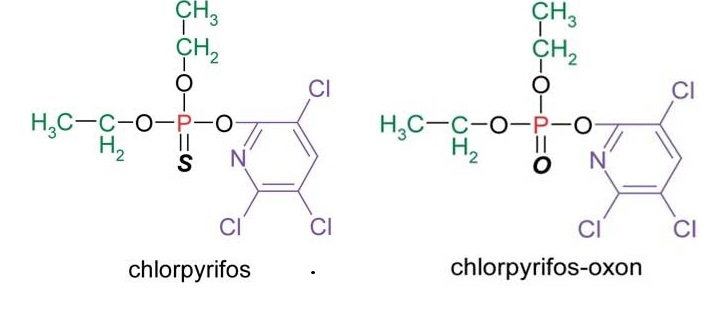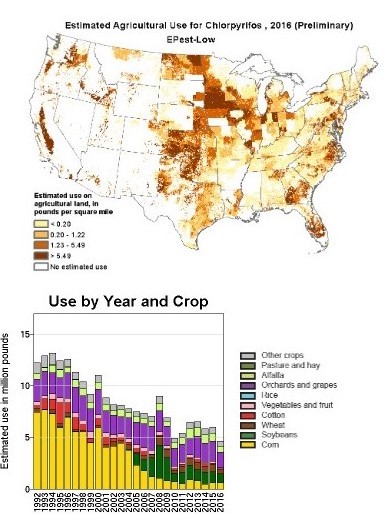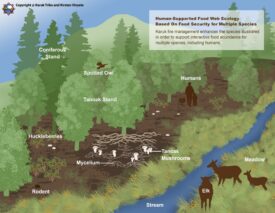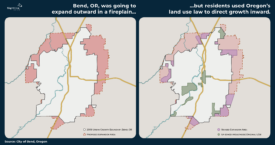Editor’s note, 12/30/2020: Readers may have noticed that John has been updating this material, in anticipation of one day reporting that the US has cancelled Chlorpyrifos (see his notes in the comments section). In the meantime, both the European Union and Health Canada, each of which unlike the US comes closer to implementing a “precautionary principle,” have banned nearly all uses of Chlorpyrifos. At the same time, the European Union also banned the chemical cousin Chlorpyrifos-methyl, used much less often in the US. The US Administrative Procedures Act establishes a deliberative process that means it will take time to reverse Trump’s actions to weaken pesticide protections; and then industry may sue. But the US Congress can take action now. Farmworker Justice, one of the organizations that Earthjustice represents against EPA on Chlorpyrifos, is petitioning Congress and the US Environmental Protection Agency. Concerned readers have the opportunity to sign on to the Farmworker Justice petition.
In early February, Corteva Agriscience, the largest manufacturer of the neurotoxic pesticide Chlorpyrifos, announced it would discontinue production of the chemical. It was probably no coincidence that the statement came the same day California banned in-state sales of the chemical. California’s decision was, in part, the result of more than a decade of pressure from farmworker and environmental organizations for the state to make up for federal government inaction.
Nearly 40 years ago, toxicology studies showed that Chlorpyrifos exposure can interfere with brain development, particularly in infants and children. Since then, evidence of the pesticide’s harmful effects on human health has steadily accumulated. Exposure is linked with neurological and respiratory complications in children, reduced fertility, and Parkinson’s disease.
These findings are especially troubling given that Chlorpyrifos is widely used to control food crop pests. Cascadia’s farmers commonly spray it on regional staples including apples, pears, cherries, Christmas trees, lentils, and wheat.
Cascadia’s farmers commonly spray Chlorpyrifos on regional staples including apples, pears, cherries, Christmas trees, lentils, and wheat.

Foresters also apply Chlorpyrifos to control bark beetles or other boring insects.
So far, no Cascadian government has banned the pesticide. Oregon and Washington lawmakers have each considered legislation to reduce exposure risks, but neither state has taken decisive action. In both 2019 and 2020, Oregon lawmakers considered bills to ban Chlorpyrifos within the state, but in each chaotic session the legislature adjourned before voting on the proposals. Washington’s legislature passed a bill this year requiring the state’s Department of Agriculture to further regulate application of the pesticide, but Governor Inslee vetoed the bill due to budget concerns related to the Covid-19 pandemic.
British Columbia has also failed to act, though the chemical is already much less common in the province than in Pacific Northwest states. In 2015, BC residents bought fewer than 5,000 pounds of Chlorpyrifos, equivalent to less than four percent the amount sprayed on Washington apples that year alone.
Despite the lack of Cascadian action, California’s leadership on Chlorpyrifos may improve the safety of the food system in the Pacific Northwest and beyond.

Chlorpyrifos and its more acutely toxic oxon metabolite, the latter formed in the body and during drinking water treatments. Source: National Pesticide Information Center, Oregon State University (public domain).
Four decades of federal inaction despite mounting evidence of harm
In 1965, the United States approved application of Chrlorpyrifos in agriculture and for residential use. Within two decades, studies began rolling in linking exposure to the pesticide with adverse health outcomes, including delayed motor function and brain development in children. Though Congress tightened national pesticide regulations in the mid-1990s, high rates of childhood exposure to the potent neurotoxin continued.
Finally, in 2000, responding to mounting evidence of harm, the United States Environmental Protection Agency (EPA) negotiated a voluntary agreement with Chlorpyrifos manufacturers to end application in locations where children are mostly likely to be directly exposed—homes, schools, and daycare centers. But food crop application continued.
Unsatisfied with the voluntary agreement, the Natural Resource Defense Council and Pesticide Action Network continued to urge the federal government to ban the chemical outright. The request fell on deaf ears until five years ago, when EPA staff at last recommended ending Chlorpyrifos application on food crops. A year later, in 2016, the EPA reiterated the guidance, adding that food exposures to all age groups exceed safe levels. Children under the age of three face exposure 140 times “acceptable” levels. Farmworker families and their neighbors also bear high risk of acute exposure.
Despite the staff’s strong recommendation, president Donald Trump’s first EPA administrator, Scott Pruitt, refused to ban the chemical in 2017, and the US federal government has not taken action since.
Health Canada recommended a near total ban on Chlorpyrifos across Canada last year. As of this writing, the Canadian federal government has yet to act.

Chlorpyrifos Use Map and Chart for 2016 (most recent year available), from US Geological Survey (public domain).
States step in
In the absence of federal action to ban Chlorpyrifos, state governments are stepping up. Attorneys general in multiple US states, including Oregon and Washington, have filed an administrative challenge against the EPA, calling on the Agency to cancel agricultural uses of the neurotoxin.
State legislators around the US are also taking action within their borders. In January, 2019, Hawaii became the first state to ban Chlorpyrifos application within its borders. California followed suit last fall, announcing that it would ban in-state sales of the pesticide by February 2020. In December 2019, New York Governor Andrew Cuomo also announced a state-wide ban, set to take effect July, 2021.
California is the largest US state by both population and agricultural sales, giving its pesticide regulations exceptional influence on the industry. Unsurprisingly, Corteva’s February announcement that it will terminate its Chlorpyrifos production followed on the heels of the Golden State’s ban.
Looking ahead
As the largest manufacturer of Chlorpyrifos, Corteva’s decision could radically slash use of the chemical across North America. Still, at least four other companies manufacture the pesticide: Cheminova, Makteshim-Agan, Gharda and Platte Chemical. None of these companies have yet announced plans to discontinue production.
California Governor Gavin Newson’s 2019 budget committed $5.7 million to look for alternative insecticides to replace Chlorpyrifos. Many of the options present risks of their own; for example, Imidacloprid and Clothianidin are neonicotinoids, a pesticide class linked with the decline in bee populations.
As the US federal government fails to act, and Canada’s lawmakers proceed with their review process, Cascadian governments could follow California’s lead and implement state- or province-wide bans. Though Oregon and Washington legislators failed to take decisive action on Chlorpyrifos in this year’s legislative sessions, they’ll have another chance next January.
John Abbotts is a former Sightline research consultant who occasionally contributes to Sightline articles. He recently served as in-house support contractor to EPA in Seattle, until he resigned in September 2019 in protest of the Trump administration’s efforts to damage the Agency’s mission to protect children and other living things.
A previous version of this article stated that the Washington legislature passed Senate Bill 6518 in its 2020 session, requiring additional in-state regulations on Chlorpyrifos application. While the bill did pass the legislature, Governor Inslee vetoed it due to budget concerns related to the Covid-19 pandemic. The article has been updated to reflect this.












John Abbotts
My thanks to Sightline’s editors for catching Gov. Inslee’s veto, news that we missed during the editing/approval process.
In addition, although not directly relevant to Cascadia, I since found that the European Union also decided not renew approval for Chlorpyrifos nor its chemical cousin Chlorpyrifos-methyl. EU details at https://euobserver.com/investigations/146858
For Chemistry majors (such as myself), Chlorpyrifos-methyl differs because the O-ethyl sidechains (above) are replaced by O-methyl ones. Although structurally similar to Chlorpyrifos, the -methyl cousin is used so little in the US that the US Geological Survey does not even list it among its pesticide use maps, link at https://water.usgs.gov/nawqa/pnsp/usage/maps/compound_listing.php
Now, although some large chemical companies are located in Europe, the continent uses pesticides at a lower rate than in the US. Nonetheless, the EU ban became effective January 31, 2020, a few days before California’s ban on sales became effective. The EU allowed member states a three month delay in establishing their own ban, but Corteva’s stated reasons for cancelling were economic, and the loss of the European market along with California’s probably contributed to the decision.
Now, one difference between EU and the US is that the former practices the “precautionary principle,” as we explained in our article on Oregon and neonicotinoids, at
https://www.sightline.org/2019/03/22/pesticides-reform-oregon-legislature-2019/
As usual, comments here are my own responsibility, and not Sightline’s. So I offer one more thought: When corporate-appeasing politicians decry “European solutions,” are they thinking that the precautionary principle is not part of US law, link at https://www.politico.com/story/2011/02/romney-to-hammer-obama-on-economy-049313
John Abbotts
Update, 9/28/2020
Oregon’s Department of Agricultural (ODA) is taking public comment on proposed rules to restrict uses of Chlorpyrifos within the state. Deadline for comments is end of the working day on October 22, 2020. Northwest Center for Alternatives to Pesticides (NCAP) is urging a complete ban on the chemical by the end of 2023.
More details, including an automatic email to ODA where citizens can add their own comments, can be found at http://www.pesticide.org/ban_chlorpyrifos_in_oregon
All stay safe, humans and other species
John Abbotts
And some more news, in case anyone is reading, Sierra Club Canada has its own campaign to “Close the Door on Chlorpyrifos.” They include a letter to Health Canada that citizens of that nation can sign, or add their own personal comments as well, link at https://www.sierraclub.ca/en/close-the-door-on-chlorpyrifos
All stay safe
John Abbotts
Another update, if Sightline’s editors will tolerate: The Northwest Center for Alternatives to Pesticides (NCAP)
just released its 2020 Year in Review report, found at https://d3n8a8pro7vhmx.cloudfront.net/ncap/pages/37/attachments/original/1608143661/NCAPandYou2020.pdf?1608143661
I think I received it cuz I did some volunteer GIS work for them a while back.
Not surprisingly, their top article was on Chlorpyrifos, its dangers and describing NCAP work with OR and WA legislatures to ban Chlorpyrifos use at the state level. Both efforts were unsuccessful for different reasons [summarized in the article above]. But NCAP noted that the Oregon Dept of Agriculture proposed a rulemaking that would eliminate most outdoor uses; and one of today’s Sightline Daily headlines has more information on that proposal. NCAP says it intends to revisit legislation in the WA legislature in 2021
Other articles in the NCAP review, in order of appearance, are:
–People are not pests. In the wake of the use of tear gas and mace against Portland protesters, this is a discussion of the history of pesticide use against populations in war [e.g., fumigants during WWI trench warfare, Agent Orange in Vietnam]
–Lessons from Organic [Agriculture] Citrus Growers
–Market Garden Pest Management, for individuals and commercial growers
–NCAP Seeks Board Members, on this item, they explain that: New board members join with an introductory term of one year, which can be renewed. Commitment of time is estimated at approximately four hours per month.
Email info@pesticide.org for more information
NCAP originated to respond to aerial spraying of Agent Orange in forests that drifted into populated areas in the 1970s [I think, but they would have more precise information on their history]. They have since expanded from their base in Eugene with Regional Offices in Boise, ID; Warm Springs, OR; and Rochester, WA
In addition to their OR work, they could use board members from ID to support organic potato farming; or from WA to support their efforts on Chlorpyrifos, which if I recall correctly is used on about half the WA apple crop.
I think they do good work, but then I am biased; they sent me a T-shirt for the volunteer GIS work I did for them years ago
All stay safe,
John Abbotts
A new update on our sane neighbors to the north: Health Canada just announced a decision on Chlorpyrifos, cancelling most crop uses except two minor crops, use for mosquito control and other specific outdoor uses. News link at https://caar.org/ag-retail-news/1345-health-canada-s-pmra-concludes-their-re-evaluation-for-outdoor-use-of-chlorpyrifos, which contains its a link to the full Health Canada decision. Canada also employs the “precautionary principle,” as noted in my interminable updates via comment above. As usual, these comments are mine only, and I take full responsibility for them
All stay safe,
John Abbotts
And, an update on EPA, which in December 2020, proposed some limited new restrictions on Chlorpyrifos to protect workers from direct exposure and to limit the pesticide in drinking water. But Earthjustice dismissed these proposals as way too inadequate, link at https://earthjustice.org/news/press/2020/epa-fumbles-new-restrictions-on-pesticide-linked-to-brain-damage
As noted in our article above, EPA’s last risk assessment during the Obama administration concluded that exposures to children are 140 times “acceptable” levels. Earthjustice reports that the 9th Circuit US Court of Appeals may rule on Chlorpyrifos litigation within months.
However, Trump’s EPA is likely to continue to stall, appeal, and allow continued exposures to children. IMHO, an administration that does not protect children has no concept of sustainability, and needs to resign now.
President-elect Joe Biden has named Michael Regan, top environmental official in North Carolina, appointed by a Democratic Governor for EPA. Regan previously worked at EPA during the Clinton and Cheney-Bush administration [we know who was in charge], news at https://www.cnn.com/2020/12/19/politics/biden-climate-team-introductions/index.html.
Now, I know that progressive organizations have chaffed at Biden, urging him not to move to the right to appease Trump extremists, as Biden promises a “unity” government. Again, this is my opinion only, but Biden/Harris recognize that the Democratic Party is in danger of a civil war within itself, and the incoming administration needs to unify the party as well. It has not escaped my notice that NC has a Democratic Governor, but remained Red in 2020; both Biden and the Democratic Senate challenger were beaten by a few percentage points. So, my theory, and this is my own, is that Joe Biden is trying to unify the party. On the one hand, he won the nomination thanks to the support of older black politicians, including James Clyburn (D-SC), Majority Whip in the US House; and one can expect that Clyburn and other African-Americans chose Biden because he [Joe] was a loyal Veep who had Obama’s back. Biden has also nominated people with whom he worked before and whom he respected. But now, he is consulting with the Dem Progressive Caucus and civil society groups, asking their input. He is walking a tight rope, but with his connections and personal contacts, he seems to be uniting the different factions and maintaining a Big Democratic Tent, while the GOP under Trump has moved to the extreme right. For what it is worth, but “I could be wrong,” as Dan Quayle [remember him?] often said.
Back to more positive action on Chlorpyrifos, Farmworker Justice, one of the organizations that Earthjustice represents in court, invites citizens to sign a petition to both EPA and ranking members in the US Congress, urging them to ban Chlorpyrifos NOW, rather than wait until Biden/Harris are inaugurated.
Requirements of the US Administrative Procedures Act establish a deliberative process that takes time to reverse all of Trump’s horrible decisions. But Congress can take action now. Concerned readers who have tracked the comments this deep into Sightline’s articles have the opportunity to sign on to the Farmworker Justice petition, at https://farmworkerjustice.salsalabs.org/fjpesticidepetition/index.html?eType=EmailBlastContent&eId=c845a9f5-321e-4d6c-90b0-2f1dc98cfbe4
As noted on that page, they are 38% [as of this comment] toward their goal of 5000 signatures. Also please note that signers have the opportunity to add their own comments and to select whether they want to display their signatures, their own comments, and/or whether they want to keep informed of further Farmworker Justice efforts.
Again, I take sole responsibility for the opinions expressed here.
All stay safe from all science denial threats,
John Abbotts
Another update from the UW Interdisciplinary Center for Exposures, Diseases, Genomics and Environment (EDGE). Three scientists within that center published in the October 2020 journal Environment International, concluding that, “For nearly 50 years, a statistical omission tantamount to data falsification sat undiscovered in a critical study at the heart of federal regulations of one of the most controversial pesticides in America,” [Chlorpyrifos]. The UW press release summarizing their work is headlined, “Data omission in key EPA insecticide study shows need for review of industry-funded research,” link to UW press release, at https://deohs.washington.edu/edge/blog/reassessing-chlorpyrifos-and-childrens-health; and the link to the published work is, https://www.sciencedirect.com/science/article/pii/S0160412020318602.
Co-authors are Professor Lianne Sheppard; Seth McGraw, graduate student at the time he performed work published in the article; and emeritus Professor Richard Fenske. Dr. Fenske’s research includes studies of chlorpyrifos exposure to children; direct exposure from household use, through “spray drift,” that exposes farmworker families and neighbors, and through the “take-home” pathway, when farmworkers come home from the field, and pesticide residues on
their clothes transfer to floors, walls, and furniture, and then exposure children. In fact, the petition to EPA described above from Natural Resources Defense Council and Pesticide Action Network cited as support scientific studies, including work completed in Dr. Fenske’s laboratory.
Now, details of the UW study are provided in the links above to press release and the published item, but the researchers reviewed a study in 1972 performed by a university scientist under contract to Dow Chemical, which Dow then sent to EPA as a formal submission to support residential uses for Chlorpyrifos.
UW researchers reached the following conclusions:
–Dow omitted key data points in the study submitted to EPA in 1972;
–The statistical analytical methods that EPA used at the time underestimated the “acceptable” exposure level by more than two-fold.
Now, this may seem small, but that difference was magnified by amendments signed into law after 1972.
–In 1988, amendments required for older pesticides, those first approved for use before 1984, EPA would review the data, especially new scientific data, and determine if all approved uses should be retained.
Yet the UW team reports that EPA failed to use better statistical techniques and software developed in the 1980s to reevaluate the 1972 data.
–In the 1990s, as noted above, changes in federal law required that pesticides be evaluated with potential effects on children, and extra safety factor(s) as specified incorporated to calculate “acceptable” exposure levels. Thus the two-fold discrepancy with the 1972 paper could be magnified by 10-fold or more, depending on what safety factors were appropriate.
Dr. Fenske’s take-away message is, “It is a cautionary tale that data being submitted for pesticide registration may not have undergone proper review, and that could be happening today.”
As usual, these comments are my own, and I bear full responsibility for any inaccuracies and misinterpretations.
But the UW study provides just one more argument against a toxic pesticide that Trump’s EPA continues to endorse.
Happy Holidays, and all stay safe,
John Abbotts
And a bit more on the study by the UW research team:
The authors conclude that between 1984 and 1999, EPA used the analysis of the 1972 study in question to establish an “acceptable exposure” to Chlorpyrifos. As a result, during that time, children were potentially exposed to unsafe doses of the chemical. The authors conclude, “It is tragic that an omission of valid data from the analysis of the [1972] Study may have adversely impacted public health for at least 15 years.” Link to the full paper at https://www.sciencedirect.com/science/article/pii/S0160412020318602
John Abbotts
Another update by comment, and again, I take full responsibility for these comments:
Earthjustice reports that in March they submitted technical comments to EPA on the Trump Administration’s last decision to allow continued use of Chlorpyrifos on food crops, at https://earthjustice.org/library/chlorpyrifos%20news; and that over 100 farmworker, public health, and environmental organizations had submitted a letter to the Biden administration urging EPA to ban Chlorpyrifos.
Earthjustice also offers citizens an opportunity to add their names to sign on to a letter urging members of Congress to ban Chlorpyrifos, at https://earthjustice.org/action/ban-this-dangerous-chemical-from-our-food?ms=drupal
As that page notes, the letter will be delivered to federal officials, it may become a part of the public record, and therefore signers should include no confidential information. The page also contains options to sign up for Fast Action via one click in the future; and/or to Opt Out of future emails from Earthjustice.
All stay safe,
John Abbotts
President Biden declared yesterday National Agriculture Day, at https://drgnews.com/2021/03/23/president-biden-officially-proclaims-march-23-as-national-ag-day/#:~:text=President%20Joe%20Biden%20has%20proclaimed,America's%20farmers%2C%20ranchers%20and%20agribusinesses.
Seems as good a time as ever to sign on to the Earthjustice letter urging Congress to ban Chloryrifos.
See link and caveats above.
All stay safe,
John Abbotts
Another month, a new Administration, another update from a Sightline Daily news item:
At the end of April, the federal court of appeals for ninth district directed EPA to issue a final regulation for Chlorpyrifos within 60 days, noting that EPA has been stalling on a decision since it received a petition from Pesticide Action Network North America (PANNA) and the Natural Resources Defense Council (NRDC), and others, including Hispanic community organizations, to revoke all food uses of Chlorpyrifos in 2007. The court held that, “During that time, the EPA’s egregious delay exposed a generation of American children to unsafe levels of chlorpyrifos,” link to the article, which contains a further link to the full decision, at https://theintercept.com/2021/04/29/chlorpyrifos-epa-brain-damage-children/
Unfortunately, the decision was split, 2-1, with Judge Bybee, appointed by W. Bush/Cheney, dissenting; he argued that EPA should be given more discretion, at https://www.documentcloud.org/documents/20693912-chlorpyrifos-9th-circuit-4-29-21
Now, one can expect the Biden administration to comply with the order, but the split decision may encourage chemical companies to appeal to the right-wing Supreme Court, now with three Trump appointees, all too willing to bow to corporate power.
All the same, concerned citizens [who have read this far into the comment chain] still have an opportunity to sign on to an Earthjustice letter to EPA urging a Chlorpyrifos ban, link at https://earthjustice.org/action/ban-this-dangerous-chemical-from-our-food?ms=drupal
As usual, the site contains a caveat that the letter will be submitted to a public agency, and signers should avoid releasing confidential information. Signers also have an option to un-check a box that puts one into an Earthjustice database for future FastAction alerts; and an option to opt-out of future emails from Earthjustice.
On with the fight, and all stay safe,
John Abbotts
Hello, Earthjustice has issued an April 2024 Update on the situation with Chlorpyrifos, at https://earthjustice.org/feature/chlorpyrifos-what-you-need-to-know
At the bottom, also includes a link to sign on to a letter to EPA. Caveat there, the letter will go to EPA and become part of their public record, so readers might not want to include any personal information.
All stay safe, [still my standard sign-off in these continuing times of science denial]